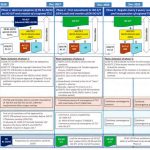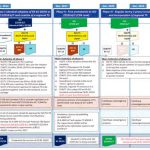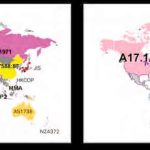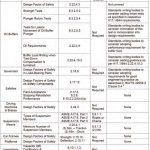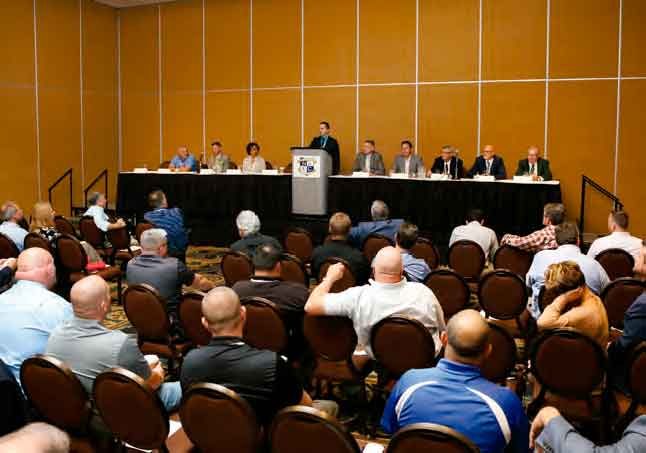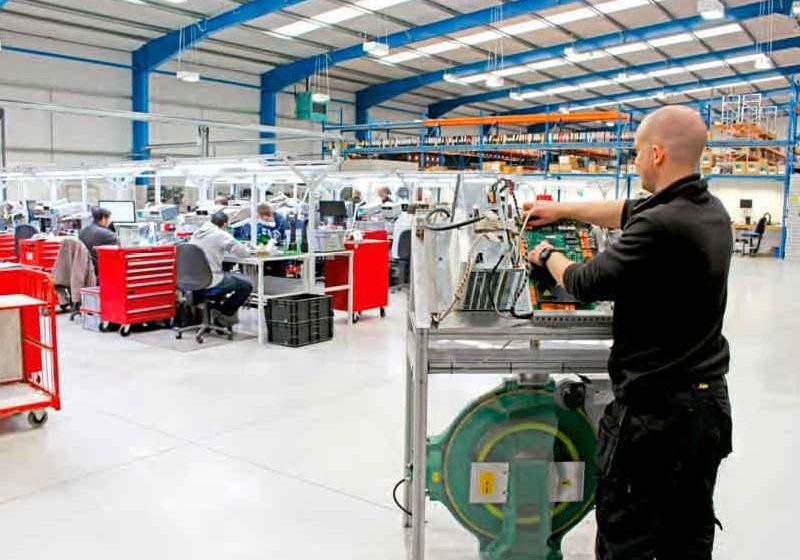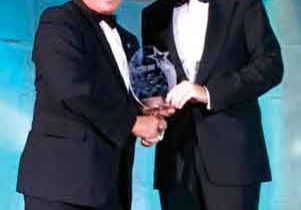Should ASME A17.1/CSA B44 “Converge” With ISO 8100?
Dec 1, 2018

The International Association of Elevator Consultants (IAEC) states its position on efforts to merge the European Norms (EN) and North American standards.
Introduction
There is currently an effort to “Converge” the European Standard EN 81-20 and -50 (ISO 8100 Parts 1, 2 and 3), a performance-based lift standard, with ASME A17.1/CSA B44, the prescriptive code, in the United States and Canada. Convergence had the goal of removing barriers to trade by creating a global prescriptive standard that would be equivalent around the world, a lofty and desirable goal, provided true equivalency is achieved. It changed to be a cut and paste of EN 81-20 and -50 with little fanfare. Where one code or standard used in any comparison is not equivalent, it should not simply be claimed without a full review. This position paper speaks against convergence until a rewrite of both A17.1/B44 and ISO 8100 is performed that is truly equivalent in reality.
Convergence
This effort is the work of the ISO Committee TC 178, the US Technical Advisory Group (TAG). (TAG is an American National Standards Institute [ANSI] term; TC 178 committees represented by different countries may not be referenced as a TAG. Membership must be approved by the standards accreditation body for that country; in the United States, ANSI is the secretariat, and in Canada, the Standards Council of Canada is the secretariat.) This group meets in the same week as the A17 Standards Committee. It reported for years about the harmonization efforts and presented a plan, a roadmap, of the convergence efforts. The goal of the World Trade Organization (WTO) and International Organization for Standardization (ISO) is to create universal standards that remove barriers to global trade by harmonizing codes and standards. This, by its nature, affects global and international manufacturers and, less so, domestic manufacturers that do not trade internationally. Therefore, the main participants are international companies, and they have the highest participation on ISO committees. Equivalent TC 178 committees from around the world studied elevator codes and standards from around the world and determined that harmonization, finding requirements that every country would agree to, was at an impasse.
The convergence roadmap was changed in 2015. This skipped the required years of work to harmonize prescriptive codes and standards to simply cut and paste the performance-based European Norms into a new ISO 8100, Parts 1 and 2. This happened because of the different WTO rules than we are used to in the United States and Canada. The US TAG was given a ballot vote, but against 28 votes in the European Union (EU), any negative from the United States and Canada would not hold up. ISO TCs also do not have maximum interest group limits, as ANSI and the Canadian Standards Association (CSA) require; they are heavily distorted toward manufacturers.
ISO operates under the rules of the WTO after signing the Technical Barriers to Trade (TBT) Agreement (tbtcode.iso.org/sites/wto-tbt/home.html):
“The World Trade Organization (WTO) Technical Barriers to Trade (TBT) Agreement aims to ensure that technical regulations, standards, and conformity assessment procedures are nondiscriminatory and do not create unnecessary obstacles to trade. At the same time, it recognizes WTO members’ right to implement measures to achieve legitimate policy objectives, such as the protection of human health and safety, or protection of the environment. The TBT Agreement strongly encourages members to base their measures on international standards as a means to facilitate trade. Through its transparency provisions, it also aims to create a predictable trading environment. . . .
“Under the TBT Agreement, WTO Members shall ensure that their central government standardizing bodies accept and comply with this Code of Good Practice, and take reasonable measures to ensure that local government, non- governmental and regional standardizing bodies also accept and comply.”
The ISO US TAG to TC 178 presented the 2014 “roadmap” of the convergence process to the ASME A17 Standards Committee in a letter ballot. (ISO has hundreds of technical committees, with members being representatives of the majority of countries around the world. TC 178 is the “Elevator” technical committee.) The roadmap provided a timeline of the convergence of various elevator codes and standards into a new ISO 22559 standard, one that would consider all the prescriptive differences and draft one that would be acceptable to all participating countries. The identified differences in the prescriptive requirements, with plans to discuss and harmonize them, were identified in Technical Report ISO/TR 11071. This is seen in the April 11, 2014, roadmap in Figure 1, A17/B44 Row, Column 2.
With a ballot vote of TC 178, the convergence roadmap changed in a significant way: in 2015, instead of using the harmonized prescriptive code that years of work went into, the new standard (initially titled ISO X, Y and Z) was numbered ISO 8100-1, 8101-2 and 8100-3. Parts 1 and 2 were then populated with EN 81-20 and -50 (formerly known as EN 81-1 and -2). The harmonization efforts were largely ignored, and the complete European Norms populated them. This is illustrated in the May 13th, 2015, roadmap, as shown in Figure 2. ISO 8100-3 was added to list the significant differences between the new ISO standard and local codes and standards, and ISO 22559 references were deleted from the revised roadmap.
The intent of the new structure was elaborated by TC 178 in Document WG4
— N125, TFC N154: “ISO TS 8100-3 is to be used in combination with ISO 8100-1 and ISO 8100-2 for the purpose of achieving equivalency with the requirements of ASME A17.1/CSA B44 and JIS X/Y respectively, where the scopes of ASME A17.1/CSA B44 and JIS X/Y coincide with the scope of ISO 8100-1 and ISO 8100-2. Equipment outside of the scope of ISO 8100-1 and ISO 8100-2 is not addressed in ISO TS 8100-3. While the scope of ISO 8100-1 and ISO 8100-2 addresses electric as well as hydraulic lifts, the current edition of ISO TS 8100-3 only addresses electric lifts (except home lifts). Future editions of ISO TS 8100-3 will address hydraulic lifts, home lifts, as well as, electric lifts.”
This vote by TC 178 illustrates, while initially touted as a harmonized global prescriptive code, the new ISO 8100 standard is simply the European Norm EN 81 cut and pasted into an ISO version and does not cover all equipment covered within the scope of A17.1/B44. The claim of equivalency is the goal as shown in the last column in the A17.1/B44 row — “A17.1/ B44 ~ ISO X/Y.” This means that if it is proposed and voted that ISO 8100 is equivalent to A17.1/B44 at the A17 committee level and added to A17.1 or any other A17 standard, all products complying with EN 81 will be arguably approved for installation in North America.
Summary
Code users who do not participate in ASME or ISO committee work in the United States and Canada should be fully apprised of this effort and its potential effects. If ISO 8100 is codified either in A17.1/B44, the model codes, by regulation or by statute as equivalent to A17.1/B44, A17.1/B44 is essentially bypassed with the following effects:
- A17.1/B44 is a prescriptive code; ISO 8100 is a Performance Standard. New products will be accompanied with certification documents, instead of code compliance.
- A codification that ISO 8100 is equivalent would potentially allow companies to claim European certification is recognized in the US and Canada.
- Longstanding prescriptive requirements will be accidentally or intentionally ignored and left to AHJs to demand proof of compliance because of dual approval schemes.
- Making technical revisions to ISO 8100 according to ANSI rules will be eliminated due to the current voting structure: the United States and Canada get 2 votes, EU countries have 28 votes with another 50 other countries primarily using EN 81 European Norms.
- The history of safety using A17.1/B44 is clear in North America; we have no safety history from the use of European- designed equipment in the US and Canada, given our societal and equipment differences.
- This will essentially make A17.1/B44 redundant and, in time, not used or recognized as global manufacturers make ever stronger cases that the European Norms are as good as our “old” codes.
- This would be a tremendous advantage to global manufacturers, leaving domestic manufacturers with higher costs than mass-manufactured imported products.
- There are no Interest Group limitations. In fact, TC 178 is primarily all manufacturers, unlike the A17 Standards Committee, where no interest category can exceed 1/3 of the total membership.
- There are significant prescriptive differences between A17.1/B44 and ISO 8100.
Conclusion
This effort singly shows that if convergence moves forward as it stands today, any further changes to its requirements by the US and Canada will not have a consensus-based chance of being changed without the majority vote of European countries. The commercial benefits of a global code should not be at the expense of how we promulgate our prescriptive code in the United States and Canada. This position paper recommends any further claims of equivalency to the published language in A17.1/B44 should be prevented until true equivalency is achieved. Further reading follows to provide background information.
Further Reading
Brief History of United States and Canada Elevator Codes
In the United States, we have promulgated elevator codes for over a century. As they developed, the first organized US national code became A17.1 in 1921:
“A17.1-2016/B44-16
“ASME FOREWORD
“The first edition of this Code was published in January 1921. It was prepared by an American Society of Mechanical Engineers (ASME) Committee on Protection of Industrial Workers with the assistance of representatives of a number of interests including manufacturers, insurance carriers, regulatory bodies, and technical societies.
“This [sixteenth] edition of A17.1 [2000] was the result of a joint effort between the ASME A17 Elevator and Escalator Committee and the CSA B44 Technical Committee to harmonize requirements between the ASME A17.1, Safety Code for Elevators and Escalators, and the CSA B44, Safety Code for Elevators.
“The seventeenth edition of the Code incorporated changes made in A17.1a-2002 and A17.1b-2003. Additionally, in Sections 8.10 and 8.11, cross-references were updated to reflect ASME A17.2-2001, Guide for Inspection of Elevators, Escalators, and Moving Walks.
“The eighteenth edition of the Code was a fully binational standard. All former deviations between the ASME A17.1 Code and the CSA B44 Code were fully addressed within this one Code.”
A17.1-2016/B44-16 is the twenty-first Edition of ASME A17.1/CSA B44 with only jurisdictional adoption differences. Our binational US/Canadian Code has served us well under the management of the ANSI consensus process and the volunteers who have contributed to the continuing development of the prescriptive code. Combining A17.1 and B44 also illustrates that harmonization is possible and simply requires effort to consider societal and experiential differences and ideally select the more robust requirements as a starting point.
The CSA B44 was first published shortly after in 1938:
“A17.1-2016/B44-16
“CSA FOREWORD
“This is the fourth edition of ASME A17.1/CSA B44, Safety Code for Elevators and Escalators. It replaces the previous editions of ASME A17.1/CSA B44, published in 2013, 2010, and 2007; and the previous editions of CSA B44, published in 2004, 2000, 1994, 1990, 1985, 1975, 1971, 1966, 1960, and 1938.
“This Code is the result of a joint effort by the CSA B44 Technical Committee on the Elevator Safety Code and the ASME A17 Committee on Elevators and Escalators to harmonize the provisions of CSA B44 and ASME A17.1. This edition of ASME A17.1/CSA B44 consists of the complete ASME A17.1 Code, with additional requirements applicable only in Canadian jurisdictions. These Canadian requirements are prefaced in the body of the Code by the following: ‘In jurisdictions enforcing the NBCC’. . . .
“CSA B44 was originally developed to facilitate the implementation of uniform legislation across Canada and to replace the existing legislation, which had proved inadequate for prevailing elevator practices. The primary purpose of the Code is to establish minimum requirements, suitable for adoption by regulatory authorities throughout Canada, for the design, installation, and maintenance of elevators, escalators, dumbwaiters, moving walks, and material lifts. It is also intended as a standard reference for architects, consulting engineers, elevator manufacturers, and building owners.”
Adoption Processes
A17.1/B44 is an American National Standard, promulgated under the standards development rules of ANSI.
“A17.1-2016/B44-16
“ASME PREFACE GENERAL
“This Code is one of the numerous codes and standards developed and published by The American Society of Mechanical Engineers (ASME) under the general auspices of the American National Standards Institute, Inc. (ANSI).
“The Code is intended to serve as the basis for the design, construction, installation, operation, testing, inspection, maintenance, alteration, and repair of elevators, dumbwaiters, escalators, moving walks, and material lifts.
“Safety codes and standards are intended to enhance public health and safety. Revisions result from committee consideration of factors such as technological advances, new data, and changing environmental and industry needs. Revisions do not imply that previous editions were inadequate.”
The highlights of ANSI rules promote a consensus process where all members of industry and the public can review and comment on all proposed code changes. This process allows consensus rulings, which, in practice, means that if there are many negative comments, the proposal will require changing until unanimity is reached or only a very few negative comments persist. Each negative comment must be addressed with reviewed responses, and only after two ballots explaining why their negatives are not being accepted within the industry’s observation can the A17 chairman rule “consensus.” This process assures the vast majority of comments are in favor of the proposed change.
“A17 Procedures for ASME Codes and Standards Development Committees
“Consensus. . . means substantial agreement has been reached by directly and materially affected interest categories. This signifies the concurrence of more than a simple majority, but not necessarily unanimity. Consensus requires that all views and objections be considered, and that an effort be made toward their resolution.”
After successful technical committee balloting, there is yet a further public review by any interested stakeholder — anyone in the whole world, should they wish, can provide a comment and recommendation for change with a rationale supporting it. This comment must be addressed by the technical committee before the code or standard is approved for publication by ASME.
Committee members must also declare an interest category, and committee procedures limit the percentage of any interest category so no one category can overwhelm the decision making.
“A17 Procedures for ASME Codes and Standards Development Committees 3.2.5 Classification of Members. In order to establish balanced representation for developing evidence of consensus on standards, consensus committee members shall be classified in accordance with the business interests of their primary source of support for committee participation. Alternates shall not be counted in determining the balance of the consensus committee. The classification system and the classifications assigned to members shall be proposed by the consensus committee, shall be subject to approval by the cognizant board, and shall be included in the supplement to the procedures. Not more than one-third of the membership of consensus committees dealing with safety codes and standards shall come from any single category without the recorded approval of the other classifications and the approval of the cognizant board.
“No single category shall have a majority on consensus committees dealing with product standards except with the recorded approval of the other classifications and the approval of the cognizant board.”
In an effort to accelerate code acceptance of new technologies, a new performance-based safety code was proposed and published. After years of using A17.7/B44.7, the performance-based code in the US and Canada, it is clear that absent prescriptive requirements, the quality, robustness and specific essential safety measures A17.1/B44 afforded have been inconsistent. Acceptance of A17.7/ B44.7 has not been achieved in several large jurisdictions in the US. The single change that A17.7/B44.7 achieved was the bypassing of the consensus process. New products go from Research and Development to an Accredited Elevator/ Escalator Certification Organization (AECO), then into the marketplace with AHJ review only. Early discussions that these technologies would be ultimately written into the prescriptive code have not materialized; once an AECO certificate was issued, the goal was achieved. There was no full review of the product, except in the marketplace, and the test was graded by failures in service, placing the public at potential hazard.
It is clearly the intent of ANSI to provide full transparency to anyone wishing to participate in the process. Some might believe this necessitates a glacial speed to change the code requirements; however, given the safety hazards involved, assessing risks by as many participants is the ideal solution when writing and publishing a code or standard that has such significant safety hazards to users and workers to be considered.
Brief History of European Norms
European elevator safety codes and standards were diversified in various countries until the formation of the EU. Early 20th-century European codes were derivations of the early 1945 ASME Safety Code for Elevators, with each country translating, modifying, editing, changing and making it their own. Then, on March 25th, 1957, a Treaty on the Functioning of the European Union (also referred to as the Treaty of Rome) and a Treaty on European Union (also referred to as the Treaty of Maastricht) were signed, forming the constitutional basis of the EU and creating the European Economic Community (EEC). It was signed by Belgium, France, Italy, Luxembourg, the Netherlands and West Germany and became effective on January 1, 1958. Today, there are 28 signatory countries, essentially including most European countries. This created a single market for goods, labor, services and capital across EEC’s member states. It also established the European Commission. To reduce the barriers to trade due to regulatory differences, the Comité Européen de Normalisation (European Committee for Standardization) (CEN), was formed in 1962. The regulations of all goods had to be evaluated, harmonized and published in many languages.
CEN Technical Committee 10 was assigned the standardization of lifts (elevators). From the original countries, as other countries became members, they ceded their codes and standards to the new European Norms. The EN 81 series for lifts and EN 115 for escalators and moving walks were first published in 1994. From the EN 81 Foreword:
“EN 81-1:1998+A3:2010
“Foreword
“After the CEN Enquiry on prEN 81-1:1994 the EU Directive on Lifts (95/16/EC) was adopted. The requirements resulting from the essential health and safety requirements of this Directive being not taken into consideration in the draft have been summarised in the Addendum prA1:1996 to prEN81-1:1994 and submitted to the members of CEN/TC 10 for approval. Having received the approval, this Addendum has been incorporated into this standard, taking into account the comments received from TC members.”
EN 81-1 and -2 were renumbered to EN 81-20 and -50, respectively, in 2014, in addition to adding significant changes to try to harmonize with some A17.1 requirements in the A3 corrigendum (addenda). Items such as uncontrolled car movement and ascending car overspeed protection were featured in this change. These prescriptive changes were, in spirit, part of the original convergence roadmap and within the principle of considering the most robust requirements a minimum after review by all parties.
Adoption Processes
Distinct from a consensus process in the US and Canada, CEN TC 10 does not require a substantial majority of agreement; it is by simple majority that requirements become a European Norm. Additionally, the basis for the harmonization of such diverse codes in all the EU countries was the use of a “performance-based methodology” to write requirements. Given the lack of interest category limitations, the ability to go from research and development to market with a Notified Body acceptance allows many designs that would be disallowed by prescriptive code requirements in the US and Canada.
Product Certification
A significant difference in product certification compliance exists in the EU from the US and Canada. CE (Conformité Européenne) marking originated in 1985. The CE marking is a symbol of free marketability in the European Economic Area (Internal Market). Products manufactured outside the EU to be sold in the EU must also be certified with a CE mark. For example, North American products that are sold in the EU must also have a CE mark. This one-way barrier will not change, adding layers of certification to US and Canadian manufacturers, in addition to North American certification requirements.
To obtain a CE mark, the manufacturer must be ISO 9000 compliant, design the product, perform a risk assessment and submit the application to a Notified Body (companies that review the application and, in some cases, physically test the function of the product). This is not how typical certification works in the US and Canada. In A17.1/B44, Section 8.3 defines components required to be listed and the specific testing requirements defined by the code writers. US and Canadian listing and labeling would not be recognized in the EU.
There are over 100 Notified Bodies in the EU; these include recognized organizations such as TÜV, Liftinstituut, Underwriters Laboratories and many others. One frailty of this system is the shopping around to different Notified Bodies; if one rejects a product, it is not unheard of that a manufacturer will continue looking for another that will certify or accept the design.
The A17.7/B44.7 performance-based code utilized AECOs that essentially do what Notified Bodies in Europe do: review a code-compliance document, review risk assessments, then decide if equivalency to the prescriptive requirements of A17.1/B44 has been achieved. This process has already proven to be inconsistent and is now considered essentially a new avenue to design something noncompliant with A17.1/B44 and then have it “approved” by the AECO to begin selling and installing where A17.7/B44.7 has been adopted.
Global Experience
For over 20 years, the major global manufacturing companies have successfully lobbied countries around the world to adopt EN 81.
Figures 3 and 4 show the only countries not adopting the EN 81 are the United States, Canada and Japan, according to TC 178.
China was persuaded to adopt EN 81 and discovered they were not members of CEN and, therefore, did not have direct influence when requesting changes to meet their unique market demands. China was installing 200,000 units a year, and, in the last 15 years, exceeded 5 million installed units and are finding growing problems on many levels. Faced with being the largest user of the European Norm yet not given a seat at the CEN table to directly influence proposed changes for their market caused China to start to withdraw from using EN 81.
China’s frustration was then mollified when the major companies determined the solution would be to convince China and other countries that the ISO code solved the problem of having a seat at the table of code writers. Whether China is aware of its still-limited participation because of the voting blocs — the EU has 28 votes, and, just like the United States, China has only one vote — it will be apparent eventually. It becomes clear that the dispersion of EN 81 as a CEN-controlled document was unpalatable, so the same players strategized that making EN 81 the new ISO 8100 gave an impression of some control, and, instead of a harmonized prescriptive code, it was a simple cut-and-paste of the European Norm.
China recently formed an ASME A17 International Working Group (WG) to begin the use of A17.1/B44 in its required efforts to provide maintenance, inspection and testing direction to its industry. This is a result of the Chinese government implementing a National Emergency Law to reduce the catastrophic incidents now occurring. Their research and conclusion was that a lack of knowledge, experience and code direction existed and needed to be attended to. A17.1/B44 fulfills all of China’s needs: a design, maintenance, repair, replacements, alteration, testing and inspection document, and the country now has a seat at the A17 committee and all subcommittees. This has been an ongoing effort that formally came to pass in May 2018 at the opening ceremonies of the World Elevator & Escalator Expo in Shanghai, China.
Specific Examples of Differences Between A17.1/B44 and ISO 8100
Examples of differences between A17.1/ B44 and ISO 8100-1 are shown here for reference. There are many more; these are a select few:
“MAINTENANCE
“A17.1-2016/B44-16 “SECTION 8.6
“MAINTENANCE, REPAIR, REPLACEMENT, AND TESTING
Section 8.6 applies to maintenance, repairs, replacements, and testing. Maintenance, repair, and replacement shall be performed to provide compliance with the Code applicable at the time of installation or alteration.
“NOTES:
- See Section 8.7 for alteration requirements.
- See ‘General’ in Preface for assignment of responsibilities.
“ISO/DIS 8100-1-2016
“7.2.3 Maintenance
“The instruction manual shall be in accordance with EN 13015. It shall inform about the identification and use of the special tools.”
A significant difference is the lack of maintenance requirements in the ISO 8100 itself; it references another European Norm, EN 13015. A read of EN 13015 shows a more performance-based methodology to establish the intervals and durations, and includes language to reduce the duration of maintenance to reduce the downtime, an absolute justification to reduce maintenance time. Under the control of CEN, any changes to EN 13015 would be dictated outside the US and Canada.
“MACHINE ROOM FLOOR STRENGTH
“A17.1-2016/B44-16
“2.1.3.2 Strength of Floor. Overhead floors shall be capable of sustaining a concentrated load of 1000 N (225 lbf) on any 2000 mm2 (3 in.2) area, and in addition, where it constitutes the floor of the main or secondary level machinery space, it shall be designed for a live load of not less than 6 kPa (125 lbf/ft2) in all open areas.
“Where the elevator driving machine is to be supported solely by the machine room floor slab, the floor slab shall be designed in accordance with 2.9.4 and 2.9.5.
“ISO/DIS 8100-1-2016
“5.2.1.8 Strength of walls, floors and ceilings
“5.2.1.8.1 The structure of the well, machinery spaces and pulley rooms shall conform to National Building Regulations and be able to support at least the loads which may be applied by the machine, by the guide rails at the moment of safety gear operation, in the case of eccentric load in the car, by the action of the buffers, by those which may be applied by the
anti-rebound device, by loading and unloading the car, etc. See also E.1.”
A17.1/B44 is primarily a prescriptive code, though efforts are in place to draft new proposals using more performance- based language. The difference between the two styles are exemplified in the floor- strength example. Explicit design values versus an assumption that the values will be properly supplied when designing the room floor strength.
“FIRE TESTING OF HOISTWAY DOORS
“A17.1-2016/B44-16
“8.3.4 Entrance Fire Type Tests
“8.3.4.1 Test of Entrance Assemblies, Horizontally Sliding and Swinging Types and Vertically Sliding Types
“8.3.4.1.1 In jurisdictions enforcing the NBCC, the fire protection rating of entrances and doors shall be determined in accordance with the requirements specified in the NBCC. Requirement 8.3.4.1.2 does not apply.
“8.3.4.1.2 In jurisdictions not enforcing the NBCC, test of elevator horizontal slide-type and swing type entrance assemblies and tests of elevator and dumbwaiter vertical slide-type entrance assemblies shall be conducted in accordance with UL 10B, or NFPA 252. Test entrance assemblies shall be constructed in accordance with Section 2.11.
“ISO/DIS 8100-1-2016
“5.3.5.2 Behaviour under fire conditions
“Landing doors shall comply with the regulations relevant to the fire protection for the building concerned. EN 81-58 or ISO 3008-2 shall be applied for the testing and certification of such doors.”
A17.1/B44 requires the UL 10B type test, which includes a hose stream test; this is not required by EN 81-58. Under the control of CEN, any changes to EN
81-58 would be dictated outside the US and Canada.
“DOOR STRENGTH “A17.1-2016/B44-16
“2.11.13.3.5 Panels and their assembled accessories shall
- (a) be capable of withstanding a force on the handle of not less than 450 N (100 lbf) in the opening direction of a closed and locked door. There shall be no permanent displacement or deformation of the handle or the door panel resulting from this force.
- (b) conform to 2.11.11.5.7.
- (c) not be permanently displaced or deformed by more than 20 mm (0.75 in.) when the panel is subjected to a force of 5000 N (1,125 lbf) in the direction of the hoistway, applied at right angles to the panel over an area of 300 mm x 300 mm (12 in.x 12 in.) at the approximate center of the panel.
“ISO/DIS 8100-1-2016
“5.3.5.2 Mechanical strength
“5.3.5.2.1 Complete landing doors, with their locks, and car doors shall have a mechanical strength such that in the locked position of landing doors and closed position of car doors:
a) When a force of 300 N, being evenly distributed over an area of 5 cm2 in round or square section, is applied at right angles to the panel/frame at any point on either face they shall resist without:
- Permanent deformation (e.g. less than 1 mm);
- Elastic deformation greater than 15 mm;
After such a test the safety function of the door shall not be affected.
b) when a static force of 1000 N, being evenly distributed over an area of 100 cm² in round or square section, is applied at right angles at any point of the panel or frame from the landing side for landing doors or from the inside of the car for car doors they shall resist without significant permanent deformation affecting functionality and safety (See 5.3.1.4 [max. clearance 10 mm] and 5.3.9.1).”
Asserting equivalence when A17.1/B44 doors must not permanently deform when 2,500 N (562 lbf ) is applied, compared to EN 81-20 doors that must not permanently deform when 1,000 N [225 lbf ] is applied is clearly not equivalent.
Task-force members of ISO TC 178 developed tables of differences between the codes. One from Mr. George Gibson, former chairman of the Mechanical Design Committee, is shown as Table 1. This table identifies significant prescriptive differences with suggestions of doing nothing or actively pursuing changes to harmonize the codes. With the advent of the cut and paste of EN 81 into ISO 8100, these future changes are now left to the vast EU majority to accept or deny without any consensus.
A Brief History of the ISO Committee Actions
2009
There is a task group on convergence (Res 269) that tries to resolve items not in total alignment (door locks, buffers, safeties, etc………………… ) in three major codes: A17/
B44, EN 81 and relevant Japanese Codes.
2010
Task Force on Convergence is trying to converge A17/B44, EN and Japanese Codes, working on 5 systems: safeties, braking systems, buffers, governors and door locks. The results and proposals of the Task Force will be forwarded to national bodies for recommended revisions to be considered.
2010
Add harmonized prescriptive text as proposed wherever possible to facilitate convergence.
2011
The Task Force on Convergence is trying to get major national codes to become more harmonized. Several documents with Task Force recommendations were distributed to various A17 working committees. Attachment 4 contains the summary recommendation of the Task Force for A17 committee consideration. Detailed documents were distributed to the various A17 working committees, based upon requirements affected.
2012
WG4 continues to work on convergence within ISO under TR11071, which has been updated; but, instead of revising further, WG4 is developing a comparison document to the specific components of three major standards (A17.1/B44, EN 81 and Japan). There were 5 components reviewed by A17 task groups of several A17 working committees. The results of all the various task groups are being combined into a report to be published. This escalator document is ISO/TR 14799-1:2012(E), available from ISO.
A quote from an ISO document regarding A17.1 follows. Clearly, A17.1 is a much more prescriptive safety code than is being claimed to the ISO community. In ISO/DTR 14799-3 (2012), the Draft Technical Report (DTR) answers questions of ISO members. Here are samplings for reference:
“ISO/DTR 14799-2 (2012)
“3.1.1.6 Is EN 115-1 a performance or a design standard?
“EN 115-1 has to be considered as a minimum requirement for safe operation of escalators and moving walks.
“3.1.2.6 Is A17.1 a performance or a design standard?
“The A17.1 code is developed as a performance standard under the procedures established by the ASME. Because of the unique nature of the industry, some rules are of a design nature, but efforts are continually underway to replace them with performance language.”
That A17.1/B44 has an “effort. . . to replace [design requirements] to performance language” may be a view of some in TC 178, but not all members.
2013
WG4 is still working on a convergence document. Most of comparison work has been completed. It is planning to publish an appendix within the GESP document to provide explanation on how to comply with factors of safety as well as EN use of “good engineering practice.”
There will be a report provided on the status of agreements with respect to items that there may be additional convergence versus areas that could not converge. In addition, descriptions will be provided to explain the differences.
2014
The Report on Convergence was completed and is to be balloted as a technical report.
Commentary on ISO committee actions was provided by committee members, Mr. George Gibson questioning how this effort would benefit the US, and including EN 81-20/-50 as an ISO standard effectively throws A17/B44 under the bus. Mr. Gibson felt that after his comparison of A17 versus EN 81, clearly, EN 81 was inadequate by comparison.
In response to this commentary, the committee chair assured everyone in the minutes that this was not an effort to “throw A17 under the bus.” He assured that one of
the WGs has been working on developing the ISO prescriptive requirements for some time. Some of this work on safety components facilitated harmonization, as well as the continued development of the prescriptive standard. He also noted that some major countries would rather use an ISO standard, rather than EN 81. The schema of creating the base documents of EN 81-20/-50 and a third document of A17/ B44 differences was first suggested as a “workable solution” at this time.
The chair further said this approach helps users outside of North America design their products for all markets if they wish, and it helps users to produce products for a world market within North America. Sales of A17.1/B44 would likely increase, as A17.1/B44 compliance is necessary to enter the North American market. A17.1/B44, being the most comprehensive in the world, would be showcased by the extra requirements needed to meet it.
The chair also commented there would be no dilution of A17.1/B44 requirements, and there would be a tendency to move towards the more stringent requirements of A17.1/B44 once the benefits of visible parameters such as Factor of Safety values become more evident to the other countries. He emphasized there was no need to adopt an ISO standard and that any product deployed in North America would have to comply with A17.1/B44. Finally, he said this proposal would be discussed and balloted by the International Standards Committee.
2015
TC 178 made the following proposal and sent it to ballot. No longer was the new ISO code to be based on the more robust differences between codes and standards; the proposition that became the ISO 8100 series would be a cut and paste of EN 81-20/-50. This was balloted in the ASME C&S Ballot System. Interestingly, the ISO committee responses were not published online; their responses are reprinted below.
“Proposal for a roadmap for EN81-20/50 to become ISO X and ISO Y
“Proposed roadmap and its deliverables for development of ISO X [ISO 8100-1], ISO Y [ISO 8100-2], and ISO Z [ISO 8100-3].
“Phase 2 – Specific actions for North America
“Commence the process of convergence of the ASME A17.1/ CSA B44 standard with ISO X [ISO 8100-1] and ISO Y [ISO 8100-2] where the scopes overlap. This would be accomplished by identifying items from the ISO/TS Z [ISO 8100-3] which might be incorporated in the revision processes of ASME A17.1/ CSA B44 and ISO X [ISO 8100-1] and ISO Y [ISO 8100-2] to reduce any divergence.
“Main Action(s) of phase 2:
- a) ISO/TC 178 to decide to amend the ISO standards
- b) ISO/TC 178 proposes VA, Parallel Approval Process,
CEN/TC 10 lead
- c) CEN/TC 10 to accept ISO proposal
- d) CEN/TC 10 to invite ISO experts to join the work
- e) Amendment is limited to the list of “items” agreed in advance
- f) Basically, regional TS remains as is
- g) CEN/TC 10 to adopt ISO as EN ISO standards and withdraw EN 81-20/50 (with a 2-year transition period)
“Phase 3 – Specific actions for North America
“USA and Canada will continue the convergence process by aligning the content of ASME A17.1/CSA B44 and ISO X [ISO 8100-1] and ISO Y [ISO 8100-2], where the scopes overlap, thus reducing the content of ISO TS Z [ISO 8100-3].
“Main Action(s) of phase 3:
- a) ISO TC 178 to decide to revise the ISO standards
- b) ISO/TC 178 to decide whether to request CEN/TC 10 to lead the revision
- c) Main objective of the revisions is to reduce regional differences through solutions that satisfy all parties involved”
- Figure 1: 2014 roadmap of the convergence process
- Figure 2: 2015 roadmap of the convergence process
- Figure 3: 1995 and 2005 global codes
- Figure 4: The expansion of EN 81, according to TC 178, in 2015
- Table-1
Get more of Elevator World. Sign up for our free e-newsletter.
